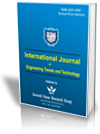Road Performance and Traffic Density Assessment on Urban Road Segments in Maros
Road Performance and Traffic Density Assessment on Urban Road Segments in Maros |
||
 |
 |
|
| © 2025 by IJETT Journal | ||
| Volume-73 Issue-10 |
||
| Year of Publication : 2025 | ||
| Author : Muhammad Ainul Amri, Muh Yamin Jinca, Lucky Caroles | ||
| DOI : 10.14445/22315381/IJETT-V73I10P107 | ||
How to Cite?
Muhammad Ainul Amri, Muh Yamin Jinca, Lucky Caroles,"Road Performance and Traffic Density Assessment on Urban Road Segments in Maros", International Journal of Engineering Trends and Technology, vol. 73, no. 10, pp.95-106, 2025. Crossref, https://doi.org/10.14445/22315381/IJETT-V73I10P107
Abstract
This study analyzes traffic performance and congestion on urban road sections in Maros Regency. The assessment applies the 2023 Indonesian Road Capacity Guidelines (PKJI) and covers road capacity, free-flow speed (Vb), and road user perceptions of congestion. Traffic performance indicators, namely Degree of Saturation (DS) and Speed Performance Index (SPI), were derived from field observations and a user survey. Results indicate a free-flow speed of 47.3 km/h and an effective capacity of 2,674 pcu/h on the observed segment. Congestion patterns are directional and time-dependent. The Maros to Makassar direction is busiest in the morning, while the Makassar to Maros direction reaches its peak in the late afternoon, with DS values at or above 0.85. The highest DS reaches 0.91, while the lowest SPI is 16, indicating severe congestion conditions. Survey responses corroborate these peak periods, aligning perceived congestion with empirical indicators. The findings provide evidence for operational controls and targeted geometric improvements to enhance traffic flow and reliability on this corridor.
Keywords
Road infrastructure, Free-flow speed, Traffic congestion, Road performance, Traffic engineering.
References
[1] Sen Zhang et al., “Deep Autoencoder Neural Networks for Short-Term Traffic Congestion Prediction of Transportation Networks,” Sensors, vol. 19, no. 10, pp. 1-19, 2019.
[CrossRef] [Google Scholar] [Publisher Link]
[2] Baiq Setiani, “Basic Principles of Air Transportation Service Management,” Widya Scientific Journal, vol. 3, no. 2, pp. 103-109, 2015.
[Google Scholar]
[3] Siti Aminah, “Public Transportation and Accessibility of Urban Communities,” Journal of Civil Engineering, vol. 9, no. 1, pp. 1142-1155, 2018.
[Google Scholar] [Publisher Link]
[4] Leni Sriharyani, and Ida Hadijah, “Traffic Congestion Due to Side Obstacles on Ki Hajar Dewantara Road, Metro City,” TAPAK (Construction Application Technology): Journal of the Civil Engineering Study Program, vol. 12, no. 2, pp. 179-189, 2023.
[CrossRef] [Google Scholar] [Publisher Link]
[5] Mohammad Imran, “Road Traffic Noise Level Study in Building Border Areas (Case Study: Maros-Makassar Main Road, KM. 5 Maccopa),” Radial: Journal of Civilization, Science, Engineering, and Technology, vol. 1, no. 2, pp. 160-185, 2013.
[Google Scholar] [Publisher Link]
[6] S.T. Sosilawati et al., Synchronization of Short-Term Development Programs and Financing 2018-2020 Integration of Regional Development with PUPR Infrastructure in Sulawesi Island, Pupr Infrastructure Integration Programming And Evaluation Center, Regional Infrastructure Development Agency, Ministry of Public Works and Public Housing, 2016.
[Google Scholar] [Publisher Link]
[7] Akanksh Basavaraju et al., “A Machine Learning Approach to Road Surface Anomaly Assessment using Smartphone Sensors,” IEEE Sensors Journal, vol. 20, no. 5, pp. 2635-2647, 2020.
[CrossRef] [Google Scholar] [Publisher Link]
[8] Aparajita Chakrabartty, and Sudakshina Gupta, “Estimation of Congestion Cost in the City of Kolkata-A Case Study,” Current Urban Studies, vol. 3, no. 2, pp. 95-104, 2015.
[CrossRef] [Google Scholar] [Publisher Link]
[9] Tanzina Afrin, and Nita Yodo, “A Survey of Road Traffic Congestion Measures Towards a Sustainable and Resilient Transportation System,” Sustainability, vol. 12, no. 11, pp. 1-23, 2020.
[CrossRef] [Google Scholar] [Publisher Link]
[10] Sujata Basu, and Pritam Saha, “Evaluation of Risk Factors for Road Accidents under Mixed Traffic: Case Study on Indian Highways,” IATSS Research, vol. 46, no. 4, pp. 559-573, 2022.
[CrossRef] [Google Scholar] [Publisher Link]
[11] Palash Chandra Das et al., “Traffic Congestion Induced Cost of a Road Section: A Study on Fulbarigate to Dakbangla Midblock, Khulna,” Journal of Engineering Science, vol. 10, no. 1, pp. 1-10, 2019.
[Google Scholar] [Publisher Link]
[12] Zhao Huang et al., “A Peak Traffic Congestion Prediction Method Based on Bus Driving Time,” Entropy, vol. 21, no. 7, pp. 1-18, 2019.
[CrossRef] [Google Scholar] [Publisher Link]
[13] Iswatun Hasanah, Bambang Setioko, and Erni Setyowati, “The Influence of Activity Support on the Visual Quality of the KH Agus Salim Street Corridor in Semarang,” Technique, vol. 35, no. 2, pp. 61-67, 2014.
[Google Scholar] [Publisher Link]
[14] Y.S. Syagata, and R. Kurniati, “Urban Renewal Settlement in Kampong Bandeng Tambakrejo Semarang Based on Business Community Preferences,” IOP Conference Series: Earth and Environmental Science: The 1st International Conference on Urban Design and Planning, Semarang, Indonesia, vol. 409, no. 1, pp. 1-10, 2019.
[CrossRef] [Google Scholar] [Publisher Link]
[15] Agus Sarwo Edi Sudrajat, “Study of Commercial Activity Characteristics in the Tlogosari Raya Corridor Area of Semarang City,” Foundation, vol. 27, no. 1, pp. 46-73, 2022.
[CrossRef] [Google Scholar] [Publisher Link]
[16] Agista Murtadinata, Wahyuningsih Point, and Anwar Efendy, “Relationship between Traffic Flow, Speed and Density on Majapahit Road, Mataram City,” Civil Engineering Vehicle, vol. 29, no. 1, pp. 205-219, 2024.
[CrossRef] [Google Scholar] [Publisher Link]
[17] Erika Buchari et al., “Analysis of Speed Changes on Traffic Accident Risk,” Journal of Indonesia Road Safety, vol. 2, no. 2, pp. 76-86, 2019.
[Google Scholar] [Publisher Link]
[18] Ismil Nur Ramadhan, and Ida Farida, “The Effect of Slowing Vehicle Flow Based on Road Traffic Performance,” Construction Journal, vol. 22, no. 1, pp. 82-89, 2024.
[CrossRef] [Google Scholar] [Publisher Link]
[19] Enzo Scifo Mambay, and Sri Yuniarti, “Performance Analysis of the Kelapa 2 Entrop Jayapura Road Section,” Journal of Civil Engineering-Architecture, vol. 21, no. 2, pp. 187-197, 2022.
[CrossRef] [Publisher Link]
[20] Greece Maria Lawalata et al., “Update of Capacity Adjustment Factor for 22-Tt Type Urban Roads Due to Lane Width,” Journal Jalan Jembatan, vol. 37, no. 2, pp. 102-115, 2020.
[Google Scholar] [Publisher Link]
[21] H. Al Faritzie, “Analysis of the Measurement of the Degree of Saturation and Level of Service of the R. Sukamto Road Section in Palembang City,” Deformation Journal, vol. 6, no. 2, pp. 131-141, 2021.
[Google Scholar]
[22] Tian Yuan et al., “Analysis of Normal Stopping Behavior of Drivers at Urban Intersections in China,” Journal of Advanced Transportation, vol. 2022, pp. 1-17, 2022.
[CrossRef] [Google Scholar] [Publisher Link]
[23] Nachuan Li et al., “Close Look into the Spatial-Temporal Distribution of Speed, Lane Changes, and Heavy Vehicles in a Congested Freeway Weaving Section,” Transportation Research Record, vol. 2679, no. 2, pp. 862-878, 2024.
[CrossRef] [Google Scholar] [Publisher Link]
[24] Nina Anindyawati, Eko Yulipriyono, and Joko Siswanto, “Analysis of the Relationship Between Travel Time and the Degree of Saturation of Urban Roads (Case Study of Semarang City),” Communication Media and Civil Engineering Development, Diponegoro University, vol. 18, no. 1, pp. 1-8, 2013.
[Google Scholar] [Publisher Link]
[25] Muhammad Isradi et al., “Analysis of Capacity, Speed, and Degree of Saturation of Intersections and Roads,” Journal of Applied Science, Engineering, Technology, and Education, vol. 2, no. 2, pp. 150-164, 2020.
[CrossRef] [Google Scholar] [Publisher Link]
[26] Dwi Prasetyanto, “Traffic Engineering and Road Safety,” National Institute of Technology, Bandung, 2019.
[Google Scholar] [Publisher Link]
[27] Allya Salsabila Putri Mulyani et al., “Analysis of the Effectiveness of Buffer Area Use on Smooth Traffic Flow at the Jamrud Ro Ro Terminal, Tanjung Perak Port,” Scientica: Scientific Journal of Science and Technology, vol. 2, no. 11, pp. 433-445, 2024.
[Publisher Link]

